Deck 32: Spectroscopy C: Nuclear Magnetic Resonance Spectroscopy
Question
Question
Question
Question
Question
Question
Question
Question
Question
Question
Question
Question
Question
Question
Question
Question
Question
Question
Question
Question
Question
Question
Question
Question
Question
Question
Question
Question
Question
Question
Question
Question
Question
Question
Question
Question
Question
Question
Question
Question
Question
Question
Question
Question
Question
Question
Question
Question
Question
Question
Question

Unlock Deck
Sign up to unlock the cards in this deck!
Unlock Deck
Unlock Deck
1/51
Play
Full screen (f)
Deck 32: Spectroscopy C: Nuclear Magnetic Resonance Spectroscopy
1
Which of the labeled protons absorbs furthest upfield in the 1H NMR spectrum? 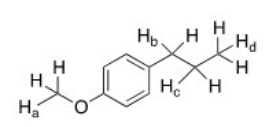
A)Ha
B)Hb
C)Hc
D)Hd

A)Ha
B)Hb
C)Hc
D)Hd
Hd
2
How many different kinds of protons are present in each of the following compounds? 
A)I = 4; II = 3; III = 1
B)I = 4; II = 4; III = 1
C)I = 4; II = 4; III = 2
D)I = 3; II = 3; III = 1

A)I = 4; II = 3; III = 1
B)I = 4; II = 4; III = 1
C)I = 4; II = 4; III = 2
D)I = 3; II = 3; III = 1
I = 4; II = 3; III = 1
3
How many unique protons are present in each of the following compounds? 
A)I = 6; II = 3; III = 6
B)I = 5; II = 4; III = 6
C)I = 6,II = 4,III = 4
D)I = 6; II = 4; III = 6

A)I = 6; II = 3; III = 6
B)I = 5; II = 4; III = 6
C)I = 6,II = 4,III = 4
D)I = 6; II = 4; III = 6
I = 6,II = 4,III = 4
4
How many peaks would be observed for each of the circled protons in the compounds below? 
A)I = 1; II = 4; III = 7
B)I = 3; II = 3; III = 7
C)I = 2; II = 4; III = 7
D)I = 2; II = 4; III = 6

A)I = 1; II = 4; III = 7
B)I = 3; II = 3; III = 7
C)I = 2; II = 4; III = 7
D)I = 2; II = 4; III = 6

Unlock Deck
Unlock for access to all 51 flashcards in this deck.
Unlock Deck
k this deck
5
Which of the following compounds does not show only one signal in its 1H NMR spectrum? 
A)I
B)II
C)III
D)IV

A)I
B)II
C)III
D)IV

Unlock Deck
Unlock for access to all 51 flashcards in this deck.
Unlock Deck
k this deck
6
How many different kinds of protons are present in each of the following compounds? 
A)I = 2; II = 4; III = 6
B)I = 2; II = 4; III = 4
C)I = 3; II = 3; III = 5
D)I = 2; II = 4; III = 5

A)I = 2; II = 4; III = 6
B)I = 2; II = 4; III = 4
C)I = 3; II = 3; III = 5
D)I = 2; II = 4; III = 5

Unlock Deck
Unlock for access to all 51 flashcards in this deck.
Unlock Deck
k this deck
7
How many different kinds of protons are present in each of the following molecules? 
A)I = 3; II = 5; III = 5; IV = 4; V = 3
B)I = 4; II = 5; III = 4; IV = 4; V = 3
C)I = 4; II = 5; III = 5; IV = 4; V = 3
D)I = 4; II = 5; III = 5; IV = 3; V = 4

A)I = 3; II = 5; III = 5; IV = 4; V = 3
B)I = 4; II = 5; III = 4; IV = 4; V = 3
C)I = 4; II = 5; III = 5; IV = 4; V = 3
D)I = 4; II = 5; III = 5; IV = 3; V = 4

Unlock Deck
Unlock for access to all 51 flashcards in this deck.
Unlock Deck
k this deck
8
How many peaks would be observed for each of the circled protons in the compounds below? 
A)I = 2; II = 6; III = 1
B)I = 3; II = 5; III = 2
C)I = 1; II = 5; III = 1
D)I = 2; II = 6; III = 2

A)I = 2; II = 6; III = 1
B)I = 3; II = 5; III = 2
C)I = 1; II = 5; III = 1
D)I = 2; II = 6; III = 2

Unlock Deck
Unlock for access to all 51 flashcards in this deck.
Unlock Deck
k this deck
9
How many peaks would be observed for each of the circled protons in the compounds below? 
A)I = 8; II = 4; III = 3; IV = 3
B)I = 7; II = 4; III = 3; IV = 4
C)I = 7; II = 3; III = 3; IV = 3
D)I = 7; II = 4; III = 2; IV = 4

A)I = 8; II = 4; III = 3; IV = 3
B)I = 7; II = 4; III = 3; IV = 4
C)I = 7; II = 3; III = 3; IV = 3
D)I = 7; II = 4; III = 2; IV = 4

Unlock Deck
Unlock for access to all 51 flashcards in this deck.
Unlock Deck
k this deck
10
How many different kinds of protons are present in each of the following compounds? 
A)I = 4; II = 4; III = 4
B)I = 4; II = 4; III = 5
C)I = 3; II = 3; III = 5
D)I = 3; II = 4; III = 5

A)I = 4; II = 4; III = 4
B)I = 4; II = 4; III = 5
C)I = 3; II = 3; III = 5
D)I = 3; II = 4; III = 5

Unlock Deck
Unlock for access to all 51 flashcards in this deck.
Unlock Deck
k this deck
11
Which of the indicated protons would absorb furthest downfield in a 1H NMR spectrum? 
A)I
B)II
C)III
D)IV

A)I
B)II
C)III
D)IV

Unlock Deck
Unlock for access to all 51 flashcards in this deck.
Unlock Deck
k this deck
12
Into how many peaks will each of the circled protons be split? (Assume complete resolution of all NMR peaks is possible) 
A)I = 3; II = 8; III = 1; IV = 4; V = 3
B)I = 9; II = 8; III = 2; IV = 4; V = 4
C)I = 4; II = 8; III = 2; IV = 4; V = 5
D)I = 4; Ii = 7; III = 2; IV = 4; V = 3

A)I = 3; II = 8; III = 1; IV = 4; V = 3
B)I = 9; II = 8; III = 2; IV = 4; V = 4
C)I = 4; II = 8; III = 2; IV = 4; V = 5
D)I = 4; Ii = 7; III = 2; IV = 4; V = 3

Unlock Deck
Unlock for access to all 51 flashcards in this deck.
Unlock Deck
k this deck
13
How many different kinds of protons are present in each of the following molecules? 
A)I = 6; II = 3; III = 4
B)I = 5; II = 3; III = 4
C)I = 6; II = 4; III = 5
D)I = 6; II = 4; III = 4

A)I = 6; II = 3; III = 4
B)I = 5; II = 3; III = 4
C)I = 6; II = 4; III = 5
D)I = 6; II = 4; III = 4

Unlock Deck
Unlock for access to all 51 flashcards in this deck.
Unlock Deck
k this deck
14
How many different kinds of protons are present in each of the following compounds? 
A)I = 2; II = 3; III = 4
B)I = 2; II = 3; III = 3
C)I = 3; II = 3; III = 3
D)I = 3; II = 3; III = 4

A)I = 2; II = 3; III = 4
B)I = 2; II = 3; III = 3
C)I = 3; II = 3; III = 3
D)I = 3; II = 3; III = 4

Unlock Deck
Unlock for access to all 51 flashcards in this deck.
Unlock Deck
k this deck
15
How many peaks would be observed for each of the circled protons in the compounds below? 
A)I = 6; II = 2; III = 3
B)I = 7; II = 3; III = 3
C)I = 7; II = 1; III = 3
D)I = 7; II = 2; III = 3

A)I = 6; II = 2; III = 3
B)I = 7; II = 3; III = 3
C)I = 7; II = 1; III = 3
D)I = 7; II = 2; III = 3

Unlock Deck
Unlock for access to all 51 flashcards in this deck.
Unlock Deck
k this deck
16
Which of the indicated protons in the molecules below would absorb furthest downfield in a 1H NMR spectrum? 
A)I
B)II
C)III
D)IV

A)I
B)II
C)III
D)IV

Unlock Deck
Unlock for access to all 51 flashcards in this deck.
Unlock Deck
k this deck
17
Into how many peaks will each of the circled protons be split? (Assume complete resolution of all NMR peaks is possible) 
A)I = 3; II = 7; III = 4
B)I = 2; II = 7; III = 4
C)I = 2; II = 7; III = 3
D)I = 2; II = 6; III = 4

A)I = 3; II = 7; III = 4
B)I = 2; II = 7; III = 4
C)I = 2; II = 7; III = 3
D)I = 2; II = 6; III = 4

Unlock Deck
Unlock for access to all 51 flashcards in this deck.
Unlock Deck
k this deck
18
Which compound does not give four sets of absorptions in its 1H NMR spectrum (i.e.,which compound does not have four unique hydrogens)? 
A)I
B)II
C)III
D)IV

A)I
B)II
C)III
D)IV

Unlock Deck
Unlock for access to all 51 flashcards in this deck.
Unlock Deck
k this deck
19
How many different kinds of protons are present in each of the following compounds? 
A)I = 6; II = 5; III = 3
B)I = 7; II = 5; III = 3
C)I = 7; II = 6; III = 3
D)I = 6; II = 6; III = 3

A)I = 6; II = 5; III = 3
B)I = 7; II = 5; III = 3
C)I = 7; II = 6; III = 3
D)I = 6; II = 6; III = 3

Unlock Deck
Unlock for access to all 51 flashcards in this deck.
Unlock Deck
k this deck
20
Which of the labeled protons would absorb furthest downfield in a 1H NMR spectrum? 
A)I
B)II
C)III
D)IV

A)I
B)II
C)III
D)IV

Unlock Deck
Unlock for access to all 51 flashcards in this deck.
Unlock Deck
k this deck
21
Which of the following statements about 13C NMR is not true?
A)"In 13C proton-decoupled NMR spectra,all peaks are singlets."
B)"13C NMR spectra display peaks for only carbons that bear hydrogen atoms."
C)"13C NMR chemical shifts occur over a greater range than 1H NMR chemical shifts."
D)"13C NMR easily differentiates between the different hybridized carbons (sp3,sp2,and sp hybridized carbons)."
A)"In 13C proton-decoupled NMR spectra,all peaks are singlets."
B)"13C NMR spectra display peaks for only carbons that bear hydrogen atoms."
C)"13C NMR chemical shifts occur over a greater range than 1H NMR chemical shifts."
D)"13C NMR easily differentiates between the different hybridized carbons (sp3,sp2,and sp hybridized carbons)."

Unlock Deck
Unlock for access to all 51 flashcards in this deck.
Unlock Deck
k this deck
22
For each of the following compounds,indicate how many 13C NMR signals will be observed. 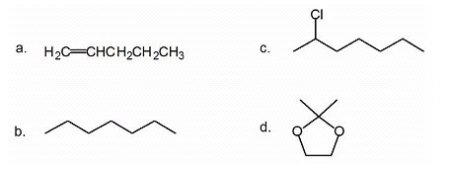
A)a: 4; b: 4; c: 7; d: 4
B)a: 5; b: 4; c: 7; d: 3
C)a: 4; b: 7; c: 7; d: 3
D)a: 5; b: 4; c: 6; d: 5

A)a: 4; b: 4; c: 7; d: 4
B)a: 5; b: 4; c: 7; d: 3
C)a: 4; b: 7; c: 7; d: 3
D)a: 5; b: 4; c: 6; d: 5

Unlock Deck
Unlock for access to all 51 flashcards in this deck.
Unlock Deck
k this deck
23
Which of the indicated protons absorbs furthest downfield? 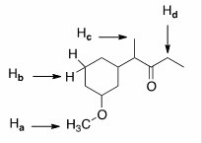
A)Ha
B)Hb
C)Hc
D)Hd

A)Ha
B)Hb
C)Hc
D)Hd

Unlock Deck
Unlock for access to all 51 flashcards in this deck.
Unlock Deck
k this deck
24
What is the relationship between Ha and Hb in the following compound? 
A)Homotopic
B)Enantiotopic
C)Diastereotopic
D)Mesotopic

A)Homotopic
B)Enantiotopic
C)Diastereotopic
D)Mesotopic

Unlock Deck
Unlock for access to all 51 flashcards in this deck.
Unlock Deck
k this deck
25
An unknown compound X has the molecular formula C6H12O2.Compound X shows a strong peak in its IR spectrum at 1700 cm-1.The 1H NMR spectral data of compound X is given below.What is the structure of compound X? 
A)I
B)II
C)III
D)IV

A)I
B)II
C)III
D)IV

Unlock Deck
Unlock for access to all 51 flashcards in this deck.
Unlock Deck
k this deck
26
What is the relationship between Ha and Hb in the following compound? 
A)Homotopic
B)Enantiotopic
C)Diastereotopic
D)Mesotopic

A)Homotopic
B)Enantiotopic
C)Diastereotopic
D)Mesotopic

Unlock Deck
Unlock for access to all 51 flashcards in this deck.
Unlock Deck
k this deck
27
An unknown compound X has the molecular formula C6H14O.Compound X shows a strong peak in its IR spectrum at 3000 cm-1.The 1H NMR spectral data of compound X is given below.What is the structure of compound X? 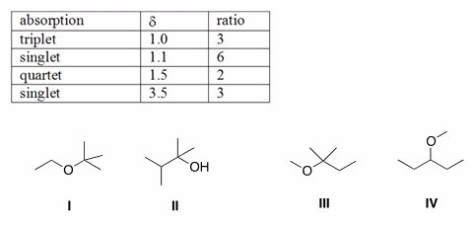
A)I
B)II
C)III
D)IV

A)I
B)II
C)III
D)IV

Unlock Deck
Unlock for access to all 51 flashcards in this deck.
Unlock Deck
k this deck
28
An unknown compound X has the empirical formula C3H6O and a molecular ion in its mass spectrum at 116.Compound X shows no IR absorption at 3200-3600 cm-1 but shows a peak at 1700 cm-1.The 1H NMR spectral data of X is shown below.What is the structure of compound X? 
A)I
B)II
C)III
D)IV

A)I
B)II
C)III
D)IV

Unlock Deck
Unlock for access to all 51 flashcards in this deck.
Unlock Deck
k this deck
29
How many different kinds of protons are present in each of the following compounds? 
A)a: 5; b: 6
B)a: 5; b: 5
C)a: 4; b: 6
D)a: 4; b: 5

A)a: 5; b: 6
B)a: 5; b: 5
C)a: 4; b: 6
D)a: 4; b: 5

Unlock Deck
Unlock for access to all 51 flashcards in this deck.
Unlock Deck
k this deck
30
An unknown compound A has the molecular formula C12H16O.Compound A absorbs strongly in the IR at 1700 cm-1.The NMR spectral data for compound A are given below.What is the structure of compound A? 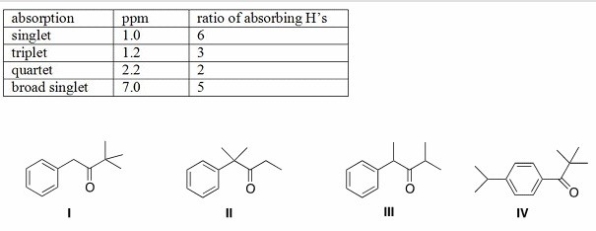
A)I
B)II
C)III
D)IV

A)I
B)II
C)III
D)IV

Unlock Deck
Unlock for access to all 51 flashcards in this deck.
Unlock Deck
k this deck
31
What region of the electromagnetic spectrum does nuclear magnet resonance spectroscopy use?
A)Radio frequency
B)Microwave frequency
C)Infrared frequency
D)Visible frequency
E)Ultraviolet frequency
A)Radio frequency
B)Microwave frequency
C)Infrared frequency
D)Visible frequency
E)Ultraviolet frequency

Unlock Deck
Unlock for access to all 51 flashcards in this deck.
Unlock Deck
k this deck
32
Into how many peaks will the circled proton be split? 
A)5
B)6
C)7
D)8

A)5
B)6
C)7
D)8

Unlock Deck
Unlock for access to all 51 flashcards in this deck.
Unlock Deck
k this deck
33
An unknown compound A has the molecular formula C7H14O2.Compound A absorbs strongly in the IR at 1700 cm-1.The 1H NMR spectral data for compound A are given below.What is the structure of compound A? 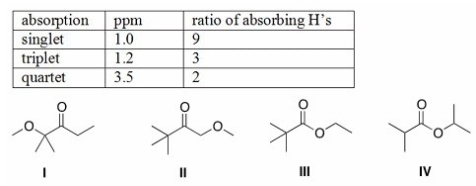
A)I
B)II
C)III
D)IV

A)I
B)II
C)III
D)IV

Unlock Deck
Unlock for access to all 51 flashcards in this deck.
Unlock Deck
k this deck
34
Which of the following compounds would give rise to a 13C spectrum with 6 peaks? 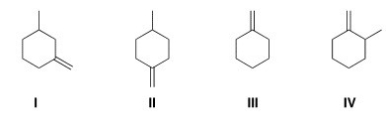
A)I
B)II
C)III
D)IV

A)I
B)II
C)III
D)IV

Unlock Deck
Unlock for access to all 51 flashcards in this deck.
Unlock Deck
k this deck
35
An unknown compound X has the molecular formula C7H13OBr.Compound X shows a strong peak in its IR spectrum at 1700 cm-1.The 1H NMR spectral data of compound X is given below.What is the structure of compound X? 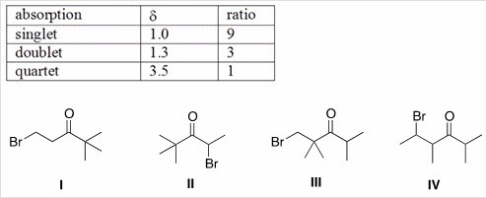
A)I
B)II
C)III
D)IV

A)I
B)II
C)III
D)IV

Unlock Deck
Unlock for access to all 51 flashcards in this deck.
Unlock Deck
k this deck
36
An unknown compound X has the molecular formula C10H11O2Br.Compound X shows a strong absorption in its IR spectrum at 1700 cm-1.The 1H NMR spectral data for compound X is given below.What is the structure of compound X? 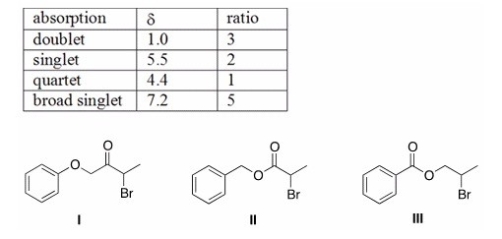
A)Only I
B)Only II
C)Only III
D)I or II

A)Only I
B)Only II
C)Only III
D)I or II

Unlock Deck
Unlock for access to all 51 flashcards in this deck.
Unlock Deck
k this deck
37
An unknown compound X has the molecular formula C6H14O.Compound X shows a peak in its IR spectrum at 3200-3600 cm-1.The 1H NMR spectral data for compound X is given below.What is the structure of compound X? 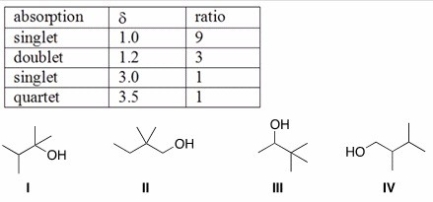
A)I
B)II
C)III
D)IV

A)I
B)II
C)III
D)IV

Unlock Deck
Unlock for access to all 51 flashcards in this deck.
Unlock Deck
k this deck
38
For each of the following compounds,indicate how many 13C NMR signals will be seen. 
A)a: 3; b: 3; c: 5; d: 3
B)a: 4; b: 3; c: 5; d: 3
C)a: 3; b: 4; c: 5; d: 3
D)a: 4; b: 3; c: 3; d: 3

A)a: 3; b: 3; c: 5; d: 3
B)a: 4; b: 3; c: 5; d: 3
C)a: 3; b: 4; c: 5; d: 3
D)a: 4; b: 3; c: 3; d: 3

Unlock Deck
Unlock for access to all 51 flashcards in this deck.
Unlock Deck
k this deck
39
How could spectroscopy be used to distinguish between the following compounds? 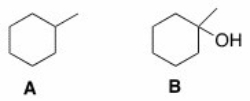
A)Compound A has a triplet in its 1H NMR spectrum at 1.0 ppm.
B)Compound B has a peak at 3200-3500 cm-1 in its IR spectrum.
C)Compound A has a peak in its IR spectrum at 2900 cm-1.
D)Compound A has a triplet in its 1H NMR spectrum at 1.0 ppm and compound B has a peak at 3200-3500 cm-1 in its IR spectrum.

A)Compound A has a triplet in its 1H NMR spectrum at 1.0 ppm.
B)Compound B has a peak at 3200-3500 cm-1 in its IR spectrum.
C)Compound A has a peak in its IR spectrum at 2900 cm-1.
D)Compound A has a triplet in its 1H NMR spectrum at 1.0 ppm and compound B has a peak at 3200-3500 cm-1 in its IR spectrum.

Unlock Deck
Unlock for access to all 51 flashcards in this deck.
Unlock Deck
k this deck
40
Compound X has a molecular formula C8H10 and gives the 1H NMR spectrum below.What is the structure of X? 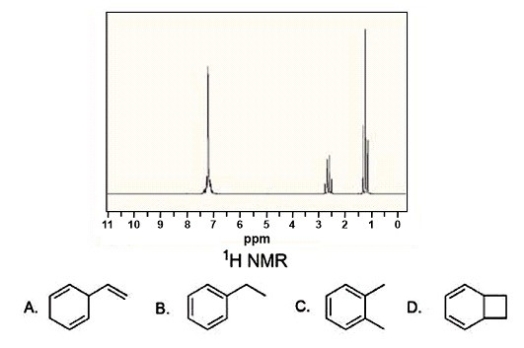
A)A
B)B
C)C
D)D

A)A
B)B
C)C
D)D

Unlock Deck
Unlock for access to all 51 flashcards in this deck.
Unlock Deck
k this deck
41
What effect does increasing the operating frequency of a 1H NMR spectrum have on the value of chemical shift in Δ?
A)Chemical shift in Δ will also increase.
B)Chemical shift in Δ will decrease.
C)Chemical shift in Δ will remain the same.
D)It is not possible to predict the change in chemical shift in Δ.
A)Chemical shift in Δ will also increase.
B)Chemical shift in Δ will decrease.
C)Chemical shift in Δ will remain the same.
D)It is not possible to predict the change in chemical shift in Δ.

Unlock Deck
Unlock for access to all 51 flashcards in this deck.
Unlock Deck
k this deck
42
Which of the following spectroscopy methods does not involve the interaction of organic molecules with electromagnetic radiation?
A)Nuclear magnetic resonance
B)Infrared spectroscopy
C)Mass spectrometry
D)Ultraviolet spectroscopy
A)Nuclear magnetic resonance
B)Infrared spectroscopy
C)Mass spectrometry
D)Ultraviolet spectroscopy

Unlock Deck
Unlock for access to all 51 flashcards in this deck.
Unlock Deck
k this deck
43
How many different kinds of protons are present in the following molecule? 
A)2
B)3
C)4
D)5

A)2
B)3
C)4
D)5

Unlock Deck
Unlock for access to all 51 flashcards in this deck.
Unlock Deck
k this deck
44
An unknown compound has the formula of C9H12.The following 1H NMR peaks were observed: Doublet at Δ 1.22
Septet at Δ 2.83
Multiplet at Δ 7.09
From the data above,pick the compound below that fits the spectra data.
A)I
B)II
C)III
D)IV
Septet at Δ 2.83
Multiplet at Δ 7.09
From the data above,pick the compound below that fits the spectra data.

A)I
B)II
C)III
D)IV

Unlock Deck
Unlock for access to all 51 flashcards in this deck.
Unlock Deck
k this deck
45
How many different kinds of protons are present in the following molecule? 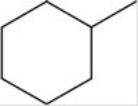
A)2
B)3
C)4
D)5

A)2
B)3
C)4
D)5

Unlock Deck
Unlock for access to all 51 flashcards in this deck.
Unlock Deck
k this deck
46
Which of the following statements is true about electromagnetic radiation?
A)All molecules absorb electromagnetic radiation at some frequency.
B)Frequency is directly proportional to wavelength.
C)NMR uses the microwave region of the electromagnetic spectrum.
D)The radio frequency region of the electromagnetic spectrum has the largest energy per photon.
E)Energy is inversely proportional to frequency.
A)All molecules absorb electromagnetic radiation at some frequency.
B)Frequency is directly proportional to wavelength.
C)NMR uses the microwave region of the electromagnetic spectrum.
D)The radio frequency region of the electromagnetic spectrum has the largest energy per photon.
E)Energy is inversely proportional to frequency.

Unlock Deck
Unlock for access to all 51 flashcards in this deck.
Unlock Deck
k this deck
47
How many different kinds of 13C peaks will be seen? 
A)2
B)3
C)4
D)5

A)2
B)3
C)4
D)5

Unlock Deck
Unlock for access to all 51 flashcards in this deck.
Unlock Deck
k this deck
48
What effect does increasing the operating frequency of a 1H NMR spectrum have on the frequency of an absorption in Hz?
A)Frequency of an absorption in Hz will also increase.
B)Frequency of an absorption in Hz will decrease.
C)Frequency of an absorption in Hz will remain the same.
D)It is not possible to predict the change in frequency of an absorption in Hz.
A)Frequency of an absorption in Hz will also increase.
B)Frequency of an absorption in Hz will decrease.
C)Frequency of an absorption in Hz will remain the same.
D)It is not possible to predict the change in frequency of an absorption in Hz.

Unlock Deck
Unlock for access to all 51 flashcards in this deck.
Unlock Deck
k this deck
49
What effect does increasing the operating frequency of a 1H NMR spectrum have on the magnitude of a coupling constant J in Hz?
A)Magnitude of coupling constant J in Hz will also increase.
B)Magnitude of coupling constant J in Hz will decrease.
C)Magnitude of coupling constant J in Hz will remain the same.
D)It is not possible to predict the change in the magnitude of coupling constant J in Hz.
A)Magnitude of coupling constant J in Hz will also increase.
B)Magnitude of coupling constant J in Hz will decrease.
C)Magnitude of coupling constant J in Hz will remain the same.
D)It is not possible to predict the change in the magnitude of coupling constant J in Hz.

Unlock Deck
Unlock for access to all 51 flashcards in this deck.
Unlock Deck
k this deck
50
How many different kinds of 13C peaks will be seen? 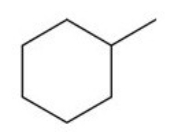
A)2
B)3
C)4
D)5

A)2
B)3
C)4
D)5

Unlock Deck
Unlock for access to all 51 flashcards in this deck.
Unlock Deck
k this deck
51
Which of the indicated protons absorbs further downfield? 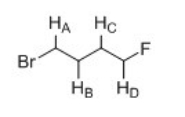
A)HA
B)HB
C)HC
D)HD

A)HA
B)HB
C)HC
D)HD

Unlock Deck
Unlock for access to all 51 flashcards in this deck.
Unlock Deck
k this deck



